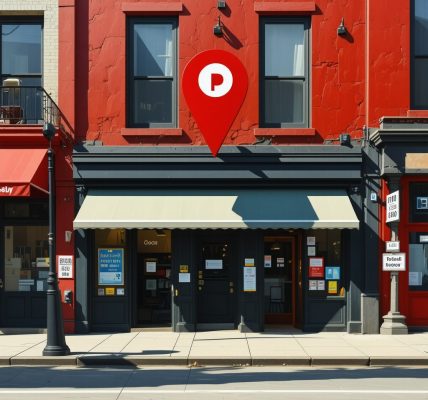Understanding the Importance of Google Maps SEO
In today’s digital landscape, Google Maps SEO is crucial for businesses looking to attract local customers. With more consumers relying on online searches to find services and products nearby, optimizing your Google Business Profile is not just beneficial; it’s essential. By maximizing your presence on Google Maps, you can drive valuable traffic to your business, enhance your visibility, and ultimately increase conversions.
Why Google Maps Optimization Matters for Local Businesses
Local businesses often compete in saturated markets, making it imperative to stand out. Google Maps serves as a powerful tool that connects users with nearby services based on their search queries. When your business is optimized for Google Maps, it appears in local search results, making it easier for potential customers to find you. This visibility can lead to increased foot traffic and higher sales, particularly for brick-and-mortar establishments.
Key Strategies to Boost Your Google Maps SEO
To effectively maximize your Google Maps SEO, consider implementing the following strategies:
1. Claim and Verify Your Google Business Profile
The first step in optimizing for Google Maps is to claim and verify your Google Business Profile. This process ensures you have control over your business information, such as your address, phone number, and operating hours, which are crucial for local searches.
2. Optimize Your Business Information
Once your profile is verified, make sure all your business information is complete and accurate. This includes selecting the right categories, writing a compelling business description, and uploading high-quality images. An optimized profile not only attracts more clicks but also encourages users to visit your physical location.
3. Utilize Keywords in Your Business Description
Incorporate relevant keywords naturally into your business description. This practice enhances your chances of appearing in search results when users look for services related to your offerings. For example, if you’re a coffee shop, keywords like “best coffee in [your city]” should be integrated into your description.
4. Encourage and Manage Customer Reviews
Customer reviews significantly impact your local SEO. Encourage satisfied customers to leave positive feedback on your Google Business Profile. Responding to reviews, both positive and negative, shows that you value customer input and helps build trust with potential clients. For more on leveraging reviews for SEO, check out our guide on GMB review generation.
5. Use High-Quality Images
Visual content plays a vital role in grabbing attention on Google Maps. Ensure that you upload high-quality images that showcase your products, services, and premises. Engaging visuals not only attract clicks but also encourage user interaction, which can improve your rankings.
Tracking Your Performance for Continuous Improvement
After implementing these strategies, it’s essential to monitor your performance. Use tools like Google Analytics and the insights provided in your Google Business Profile to track how visitors interact with your listing. This data can help you refine your strategies and improve your local SEO over time.
In conclusion, optimizing your Google Maps SEO is an ongoing process that requires attention to detail and a commitment to best practices. By implementing these strategies, you can enhance your visibility, drive valuable traffic, and ultimately grow your business in the competitive local market.
Enhancing Your Google Maps Visibility Through Advanced Techniques
To truly capitalize on the advantages of Google Maps SEO, businesses must go beyond the basics of optimization. Advanced strategies can help your business not only appear in local searches but also dominate them. By employing a comprehensive approach, you can ensure your business stands out among competitors.
Leverage Local Keywords for Targeted Visibility
Utilizing local keywords is essential for effective Google Maps optimization. Incorporate phrases that potential customers might use when searching for services in your area. For instance, if you run a bakery in San Francisco, use keywords like “best bakery in San Francisco” throughout your profile. This increases the chances of your business appearing in searches relevant to local users. For further insights into keyword strategies, explore our post on improving your Google Business SEO with keywords.
Optimize for Voice Search
With the rise of voice search, optimizing your Google Maps listing for voice-activated queries has become crucial. People often use natural language when speaking to devices. Incorporate conversational phrases and questions that users might ask. For example, instead of just listing your services, include phrases like “Where can I find the best pizza near me?” This approach can significantly enhance your visibility in voice search results.
Engage with Your Audience Through Posts
Regularly updating your Google Business Profile with posts can engage your audience and improve your SEO. Share updates about new products, promotions, or events. This not only keeps your listing fresh but also encourages user interaction, which can boost your ranking. For detailed strategies on how to use posts effectively, check out our guide on using GMB posts for engaging local SEO content.
Utilize Google My Business Questions and Answers
Another feature of Google My Business is the Questions and Answers section, where potential customers can ask questions about your business. Proactively posting FAQs can provide valuable information to users and demonstrate your expertise. Responding promptly to any inquiries not only enhances user experience but also signals to Google that your business is active and engaged, which can positively influence your rankings.
Implementing Local Link Building Strategies
Building quality backlinks from local websites can significantly enhance your Google Maps SEO. Reach out to local blogs, newspapers, and community websites to feature your business. Consider sponsoring local events or charities to create opportunities for backlinks. Each link serves as a vote of confidence in your business, helping to improve your authority and visibility in local search results. For more guidance on effective backlink strategies, explore our article on backlink building strategies for 2025.
Monitor Your Competitors
Keeping an eye on your competitors is essential for any successful Google Maps SEO strategy. Analyze their profiles, customer reviews, and engagement tactics. Tools like SEMrush or Moz can help you understand their keyword performance and backlink strategies. By identifying gaps and opportunities, you can refine your approach and stay ahead in local search rankings.
Utilizing Call-to-Actions (CTAs)
Incorporating effective CTAs in your Google Business Profile can guide potential customers towards taking specific actions, such as visiting your website or calling your business. Ensure your profile includes clear CTAs that align with your business goals. Whether it’s “Order Now,” “Call Us Today,” or “Visit Our Website,” a strong CTA can lead to increased engagement and conversions.
Utilizing Google Business Insights for Strategic Improvements
One of the most powerful features of your Google Business Profile is the Insights tool, which provides valuable data about how customers interact with your listing. By analyzing metrics like search queries, customer actions, and views, businesses can gain a clearer understanding of their performance. This data allows you to adjust your SEO strategies effectively, focusing on aspects that drive the most engagement. For more detailed analysis techniques, refer to our article on tracking GMB performance.
Optimize Your Business Description for Better Engagement
Your business description is an essential element for attracting potential customers. It should not only be informative but also optimized for relevant keywords. This is where creativity meets SEO; consider utilizing storytelling to convey your brand’s unique value. Include details that resonate with your target audience, such as your mission, history, and what sets you apart from competitors. For more tips on crafting an engaging business description, check out our guide on creating an effective GMB business description.
Harnessing the Power of Social Proof
Social proof, particularly in the form of customer reviews, is a significant factor in local SEO. Encourage your customers to leave positive feedback on your Google Business Profile. Not only does this improve your credibility, but it also enhances your visibility in search results. Engaging with customers through responses to reviews can further demonstrate your commitment to customer satisfaction. For strategies on optimizing reviews, see our post on GMB review generation best practices.
Leveraging User-Generated Content
User-generated content (UGC), such as photos and testimonials provided by customers, can significantly boost your local SEO efforts. Encourage patrons to share their experiences on social media and tag your business. This not only creates a sense of community but also provides authentic content that can enhance your listing. Additionally, featuring UGC on your website can improve your SEO by providing fresh and relevant material, which search engines favor.
Developing a Local Content Marketing Strategy
Creating localized content is another effective way to enhance your Google Maps SEO. Consider writing blog posts, guides, or creating videos that address local events or topics relevant to your community. This type of content can attract local traffic and establish your business as a valuable resource. For insights on local SEO strategies, explore our article on local SEO ranking tips.
Understanding the Role of Citations in Local SEO
Citations are mentions of your business name, address, and phone number (NAP) across various online platforms. Consistent citations can help improve your local search rankings. Ensure that your NAP information is accurate and uniform across all platforms, including directories and social media. For effective citation management strategies, visit our page on GMB citation management.
Creating a Mobile-Friendly Experience
With an increasing number of users relying on mobile devices for local searches, ensuring that your website is mobile-friendly is critical. A responsive design enhances user experience, which can lead to higher engagement rates and lower bounce rates. Google prioritizes mobile-friendly websites in search results, so optimizing your site for mobile is essential for successful Google Maps SEO.
Enhancing Your Google Maps SEO Through Local Partnerships
Building local partnerships can significantly enhance your Google Maps SEO. Collaborate with other local businesses to create mutual promotions, events, or cross-marketing strategies. This not only strengthens community ties but also generates backlinks to your Google Business Profile, which can improve your local search rankings. For tips on effectively managing local partnerships, refer to our guide on GMB citation services.
Utilizing Google Business Messaging
Engaging with potential customers directly can improve your Google Maps visibility. Google Business Messaging allows users to send messages to your business directly from your profile. By responding promptly, you enhance customer service and encourage potential clients to choose your business. For more insights on effective communication with customers, check out our article on leveraging positive reviews.
Creating Engaging Video Content
Video content is incredibly effective in attracting attention and boosting engagement. Consider creating short videos that showcase your products, services, or behind-the-scenes looks at your business. Uploading these videos to your Google Business Profile can enhance your listing and make it more appealing. For additional strategies on content creation, refer to our post on keeping listings engaging.
Implementing Schema Markup
Schema markup helps search engines understand the content of your website better, which can improve your visibility in local search results. By implementing local business schema on your website, you can provide detailed information about your business to search engines. This can lead to enhanced listings in search results, including rich snippets that attract more clicks. For more details on schema and its benefits, read our article on local SEO optimization techniques.
Optimizing for Local Events and Holidays
Take advantage of local events and holidays by optimizing your Google Business Profile to align with seasonal trends. Update your offerings, promotions, or special hours during these periods to attract more visitors. Tailoring your content to local events can significantly boost your visibility in search results. For ideas on optimizing your content for seasonal trends, explore our post on ranking higher in the local 3-pack.
Understanding the Role of Online Directories in Local SEO
Online directories play a crucial role in enhancing your Google Maps SEO. Ensure that your business is listed in relevant directories and that your information is consistent across all platforms. This consistency helps build trust with search engines and can improve your rankings. For effective directory management strategies, visit our page on GMB citation management.
The Importance of Consistent NAP Information
Consistency in your Name, Address, and Phone Number (NAP) across all online platforms is vital for local SEO. Inconsistent information can confuse potential customers and hurt your rankings. Regularly audit your listings to ensure that your NAP information is accurate everywhere it appears. For more tips on maintaining consistency, refer to our guide on GMB SEO audit.
Frequently Asked Questions About Google Maps SEO
1. What is Google Maps SEO and why is it important?
Google Maps SEO refers to the process of optimizing your business listing on Google Maps to improve visibility in local search results. It is crucial because it helps local businesses attract more customers, increase foot traffic, and enhance online presence, especially in competitive markets.
2. How can I improve my Google Business Profile?
To enhance your Google Business Profile, ensure that your business information is complete and accurate, utilize relevant keywords in your description, upload high-quality images, and actively manage customer reviews. Regularly updating your profile with posts about promotions or events can also boost engagement.
3. What role do customer reviews play in Google Maps SEO?
Customer reviews significantly influence your Google Maps SEO performance. Positive reviews enhance your credibility and visibility in search results, while actively responding to reviews demonstrates customer engagement and care, further improving your standing in local searches.
4. How can I track my Google Maps SEO performance?
You can track your Google Maps SEO performance using tools like Google Analytics and the insights from your Google Business Profile. These tools provide data on customer interactions, search queries, and engagement metrics, allowing you to refine your strategies based on real-time feedback.
5. What are local keywords and how should I use them?
Local keywords are phrases that potential customers use when searching for services in their area. Incorporating these keywords naturally into your Google Business Profile and website content can enhance your visibility in local searches, making it easier for customers to find your business.
6. Can I optimize my Google Maps listing for voice search?
Yes, optimizing for voice search is essential. Incorporate natural language and conversational phrases in your Google Business Profile. Think about the types of questions users might ask, such as “Where can I find the best pizza near me?” to improve visibility in voice search results.
7. How does mobile optimization affect Google Maps SEO?
With an increasing number of users searching for local businesses on mobile devices, having a mobile-friendly website is critical for Google Maps SEO. A responsive design improves user experience, leading to higher engagement rates and lower bounce rates, which can positively impact your rankings.
8. What are citations and why are they important?
Citations are mentions of your business name, address, and phone number (NAP) across various online platforms. Consistent citations build trust with search engines and can significantly improve your local search rankings, making it essential to ensure your NAP information is accurate everywhere it appears.
9. How can I utilize social media for Google Maps SEO?
Social media can enhance your Google Maps SEO by driving traffic to your Google Business Profile. Share engaging content, encourage user-generated content, and interact with your audience to foster a community around your brand, which can indirectly boost your local search visibility.
10. What are some common mistakes to avoid in Google Maps SEO?
Common mistakes include inconsistent NAP information, neglecting customer reviews, failing to update your profile, and not using relevant keywords. Avoiding these pitfalls is crucial for maximizing your Google Maps visibility and overall local SEO success.
Authority Resources for Google Maps SEO
For those looking to deepen their understanding of Google Maps SEO and enhance their strategies, the following resources are highly recommended:
- Moz Local SEO Guide – A comprehensive resource on local SEO principles and practices.
- Search Engine Land – A leading publication that covers the latest trends and insights in search engine marketing.
- Search Engine Journal – Offers expert advice, tips, and news on SEO and local marketing strategies.
- Neil Patel’s Blog – A wealth of information on SEO, including actionable strategies to improve local search visibility.
- Entrepreneur – Provides articles and insights on effective business marketing strategies, including local SEO.
Conclusion
In conclusion, mastering Google Maps SEO is essential for any local business aiming to enhance its visibility and attract more customers. By implementing the strategies discussed, from optimizing your Google Business Profile and utilizing local keywords to engaging with customers through reviews and social media, you can significantly boost your local search rankings. Remember, local SEO is an ongoing process that requires regular updates and engagement, so stay proactive to reap the benefits in the competitive landscape of digital marketing.


